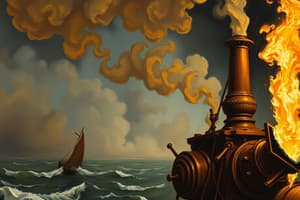Podcast
Questions and Answers
What is the primary purpose of hazard symbols?
What is the primary purpose of hazard symbols?
- To explain the process of combustion
- To explain why a substance must be handled carefully (correct)
- To indicate the type of fossil fuel used
- To describe the effects of acid rain
What is the result of incomplete combustion?
What is the result of incomplete combustion?
- Carbon monoxide and carbon dioxide
- Carbon dioxide, water, carbon monoxide, and carbon (soot) (correct)
- Nitrogen oxides and sulfur dioxide
- Carbon dioxide and water only
What is the main cause of acid rain?
What is the main cause of acid rain?
- Carbon dioxide and oxygen
- Sulfur dioxide and nitrogen oxides (correct)
- Carbon monoxide and nitrogen
- Hydrocarbons and oxygen
What is the primary function of catalytic converters?
What is the primary function of catalytic converters?
What is the result of the greenhouse effect?
What is the result of the greenhouse effect?
What is the best way to control global warming?
What is the best way to control global warming?
What is a common characteristic of hydrocarbons?
What is a common characteristic of hydrocarbons?
What is the purpose of cobalt chloride paper in testing for combustion products?
What is the purpose of cobalt chloride paper in testing for combustion products?
What is the principle of conservation of mass in reactions?
What is the principle of conservation of mass in reactions?
Why should oil fires not be treated with water?
Why should oil fires not be treated with water?
What is the purpose of the fire triangle?
What is the purpose of the fire triangle?
What is the effect of using a water extinguisher on a fire?
What is the effect of using a water extinguisher on a fire?
Flashcards are hidden until you start studying
Study Notes
Hydrocarbons and Combustion
- A hydrocarbon is a compound made up of only carbon and hydrogen atoms.
- Many fuels are primarily composed of hydrocarbons.
- Hydrocarbon combustion reaction: hydrocarbon + oxygen → water + carbon dioxide
- Combustion is also an oxidation reaction, as it involves the reaction of a substance with oxygen.
Testing for Products of Combustion
- Limewater turns cloudy to indicate the presence of carbon dioxide.
- Cobalt chloride paper turns pink to indicate the presence of water.
Conservation of Mass
- The law of conservation of mass states that the mass of reactants is equal to the mass of products in a chemical reaction.
- Metals can appear to gain mass when heated in air, but this is due to the mass of oxygen that reacts with the metal.
- When a hydrocarbon fuel combusts, it appears to lose mass because the products of the reaction (carbon dioxide, water vapor) are lost into the air.
The Fire Triangle and Fire Extinguishers
- The fire triangle consists of three essential factors for a fire to burn: fuel, oxygen, and heat.
- Removing any one of these factors can extinguish a fire.
- Different types of fire extinguishers work in various ways, including:
- Water extinguishers: remove heat
- Powder and carbon dioxide extinguishers: exclude oxygen
- Foam extinguishers: remove heat and exclude oxygen
Hazard Symbols and Air Pollution
- Hazard symbols are used to indicate the potential dangers of a substance and the necessary precautions for handling it.
- Burning fossil fuels can lead to air pollution, which can harm habitats and organisms.
- Incomplete combustion of fossil fuels can produce pollutants such as carbon monoxide, sulfur dioxide, and nitrogen oxides.
Acid Rain and the Greenhouse Effect
- Acid rain is formed when sulfur dioxide and nitrogen oxides in the air react with water.
- The greenhouse effect is the warming of the Earth's surface due to greenhouse gases such as carbon dioxide in the atmosphere.
- Global warming is the predicted result of an increase in the Earth's temperature due to the increased levels of carbon dioxide in the atmosphere, leading to climate change.
Key Vocabulary
- Law of conservation of mass: the idea that mass is not lost or gained during a chemical reaction.
- Metal: an element that is shiny when polished, conducts heat and electricity well, is malleable and flexible, and often has a high melting point.
- Metal oxide: a metal that has combined with oxygen in a chemical reaction.
- Non-metal: an element that is not shiny and does not conduct heat and electricity well.
- Oxidation: reacting with oxygen.
- Oxide: a compound that contains oxygen, often formed through the reaction of a metal with oxygen.
Studying That Suits You
Use AI to generate personalized quizzes and flashcards to suit your learning preferences.



